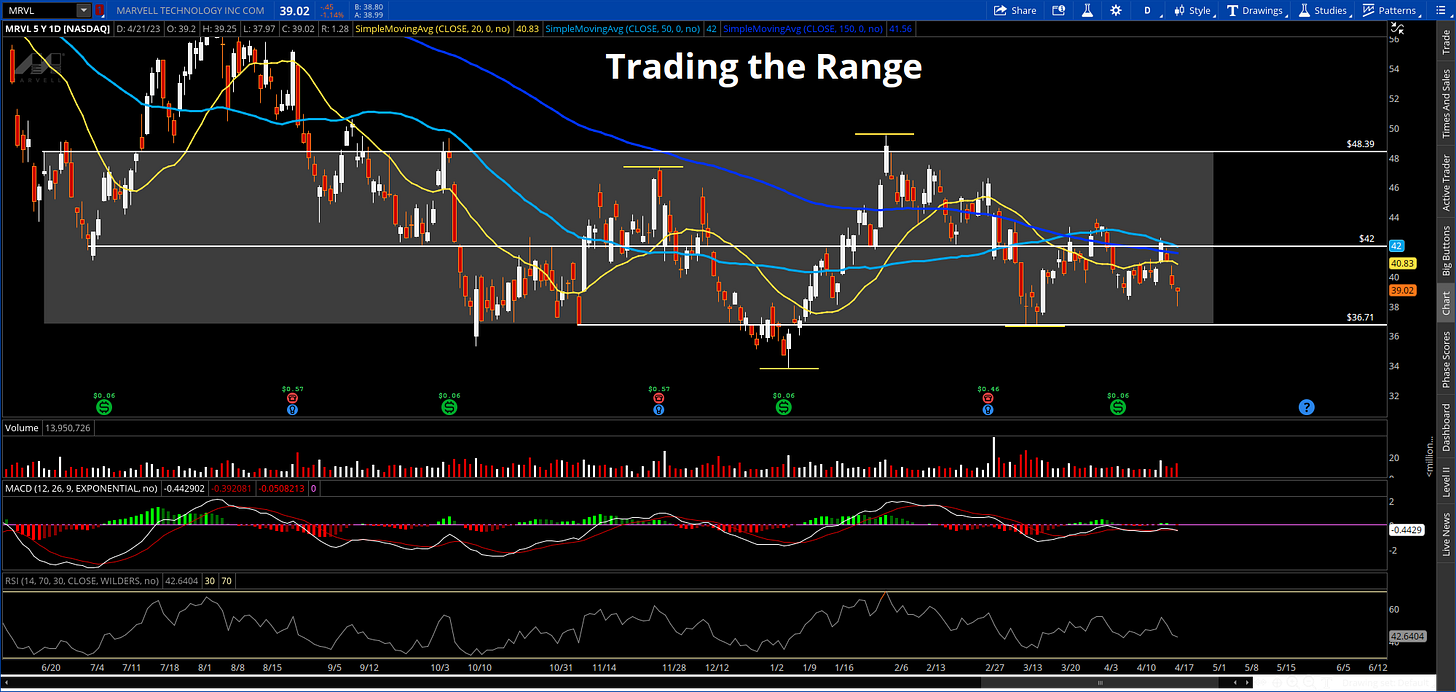Profiting from Options - Mistakes to Avoid
Plus, when to trade "In-the-money" options vs "out-of-the-money" options.
This service is for general informational and educational purposes only and is not intended to constitute legal, tax, accounting or investment advice. These are my opinions and observations only. I am not a financial advisor.
I was sitting on my couch watching the talking heads on everyone’s favorite financial news channel when they started discussing the volatility crush that was going on.
Earning season had kicked into high gear.
I remember hearing talk about “out-of-the-money” options and someone going on about premiums moving quickly and something called an “IV crush” - whatever that meant.
I just drank my caffeine and soaked it up, most of the time feeling confused but interested.
This was at the beginning. When I was first learning about trading. And I remember how intimidating options trading felt.
I had already earned a degree in Economics as well as my MBA, and had a passion for investing. But it seemed like the options trading world had a whole other language to it.
“I’ll never trade options, too risky.” I distinctly remember this thought.
Several years later, here we are with another earnings season upon us but my thoughts are much different. Why? I figured out the truth about options.
The truth is, options are not as complicated as they seem on the surface and they can be used very effectively to both manage risk and increase returns.
The lingo can sound advanced or even sexy, but in reality there are simple definitions to nearly every term you will come across. I thought it would be good timing to break down a few of them and their importance.
And then we’ll of course take a look at next week’s trading.
Common Mistakes of New Options Traders
You have heard plenty of stories about people blowing their account up by leveraging and making poor decisions. I’m sure you’ve also seen traders posting “300% gains!!” all over Twitter.
Traders that are new to the options world are often excited about the big potential returns. What is overlooked is the amount of risk that is taken to get these returns and the many losing trades made on the way.
I am all for taking measured risk and this can include speculating with options, but to do this you must understand how options work.
A common mistake is a focus on trading out-of-the-money (OTM) options for all trades. These contracts are often less expensive which can be appealing if you do not know what you are looking for.
Simply buy what you can afford, right? Actually, this is very wrong.
When buying options, you should not be trying to find an option that fits a budget. Instead, you should be looking for the right options at the right price.
Yes, this does mean that you will be limited with some trades. I’ll take limited trades over losing trades any time.
New traders should instead be looking at options that are in-the-money (ITM), which are lower risk and have some intrinsic value.
So what does all of this mean? A few quick definitions:
Intrinsic Value: The value of the option if exercised today ($10 stock - $8 option strike price = $2 intrinsic value).
Extrinsic Value: The value of the option derived by time value (time to expiration) and implied volatility. If the $2 option above is priced at $2.50, there is 50 cents of extrinsic value.
Implied Volatility (IV): An estimate of the future variability of the underlying asset (stock). Higher IV leads to higher extrinsic values.
ITM Options: The share price is past the strike price of the option, giving the option intrinsic value in addition to extrinsic value.
OTM Options: The share price has not yet reached the strike price of the option, meaning it has no intrinsic value. The option price is 100% extrinsic value.
When you buy an ITM option you know exactly what the intrinsic and extrinsic values are because you can calculate them.
If a call option has a price of $2.50 with an $8 strike price and the underlying stock is priced at $10.00, we know the intrinsic value is $2 ($10-$8) and the extrinsic value therefore must be $0.50.
Conversely, when you buy an OTM option you are only buying extrinsic value. A call option with an $11 strike price option for the same $10.00 stock might only be priced at $0.20 and 100% of that is extrinsic value.
Without going into a lot of complicated math, it is easy to see why ITM options are a better strategy for new traders. There is less required to make a profit.
Going back to the example, let’s assume the $10.00 stock drops to $9.50. The $8 strike price option still has intrinsic value of $1.50. That is the minimum it will be worth.
Looking at the OTM call option with a strike price at $11 tells a different story. If the stock is lower by expiration no matter by how much, the $11 strike option is worthless.
In fact, if the stock drops, stays flat, or increases by less than $1.00…the OTM option with the $11 strike is worthless. The odds are stacked against it.
Meanwhile, buying the ITM call option in this example would allow for some return of capital if the share price drops and most of the capital returned if the stock is flat.
Profits show up if the share price is above $10.50, only a 50 cent move higher rather than the necessary $1.00 move higher to break even for the OTM option.
Here’s an example using NIO calls. You can see the probability of the ITM option to finish OTM is only 4.47% where starting with the OTM option sees your odds of remaining OTM jump to 74.08%.
Putting the odds in your favor is always a good idea and when you are learning how to trade options, I recommend doing as much as you can to improve your chances.
I also recommend using ITM or at-the-money (ATM) options instead of OTM options when you are less certain about a trade. Again, help improve the odds of executing a favorable trade.
The temptation will be there to buy multiple OTM contracts instead of a single or just a couple of ITM contracts. That is because you are looking at how much you can profit before looking at how much you can lose. This is the wrong approach.
Instead, utilize ITM options and when the trade works in your favor consider using OTM options to roll and capture additional profits.
Rolling to a higher, OTM option means you are closing the original option, collecting those profits, and using a portion of them to buy a new option at a higher strike price.
This is how I prefer to use OTM options.
My second favorite way to utilize OTM options is the covered call strategy. Selling OTM options puts the odds in your favor. You’re selling the contracts that are likely to expire worthless.
It is important to understand all of these terms and concepts to maximize the gains you can achieve by adding options trading to your overall strategy.
Trading this Week
I am looking squarely at tickers $MRVL and $ON from the semiconductor industry. Let’s start with the former.
MRVL is back to the bottom of its range allowing for accumulation of shares or a potential entry using options.
I like picking up shares between $37 and $40 and looking to unload at $42, $45, and $48.
For options trading, I’m considering the $37 strike call options expiring May 12th for about $3 each. Stop loss at -50% risking $150 per contract with an opportunity to make +66% on a move to $42.
Additionally, the call option would see gains of +100% if MRVL gets to $45, and just crushing it at +200% if the share price makes it all the way to the top of the channel.
Next up, ticker ON has continued to move higher and higher. I want to see this level hold and then a bounce back to create new highs.
I like accumulating shares between $70 and $75 with profit taking targets at $80, $85, and $87.
I am going to wait on utilizing options for the break above $87 with strength. Before then, the risk of trading sideways and burning up cash in options is too high for my liking.
Twitter Spaces - Chart Reviews, Trading Strategies
Quick Reminder and thank you to everyone that tunes in!
Every weekend I am hosting a Twitter Space with Shaun Clarke - @ShaunClarke_ and Kaye @InvestKaye reviewing dozens of charts and talking strategies for the upcoming week.
It is a great way to sharpen your chart analyzing skills while hearing about what we are each looking at for the upcoming week.
Link to this week’s Twitter Space recording:
I hope you find this information useful each and every week.
If you have any questions, be sure to find me on Twitter @tradernatehere and send me a DM! I am always up for talking trading.
Also, be sure to follow for daily posts as I pursue my goal of educating thousands on the many ways trading options can accelerate you path to early retirement and building generational wealth. All while working your 9 to 5.
Have a great week of trading ahead!
-Nate









